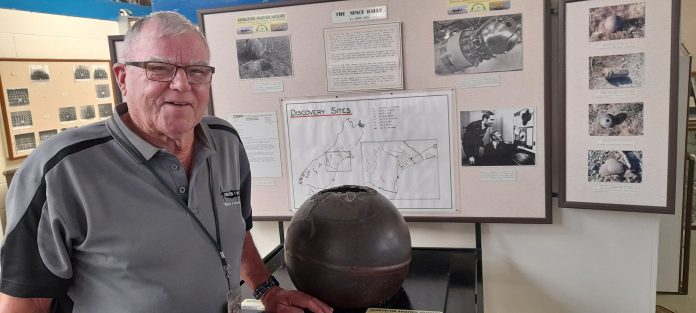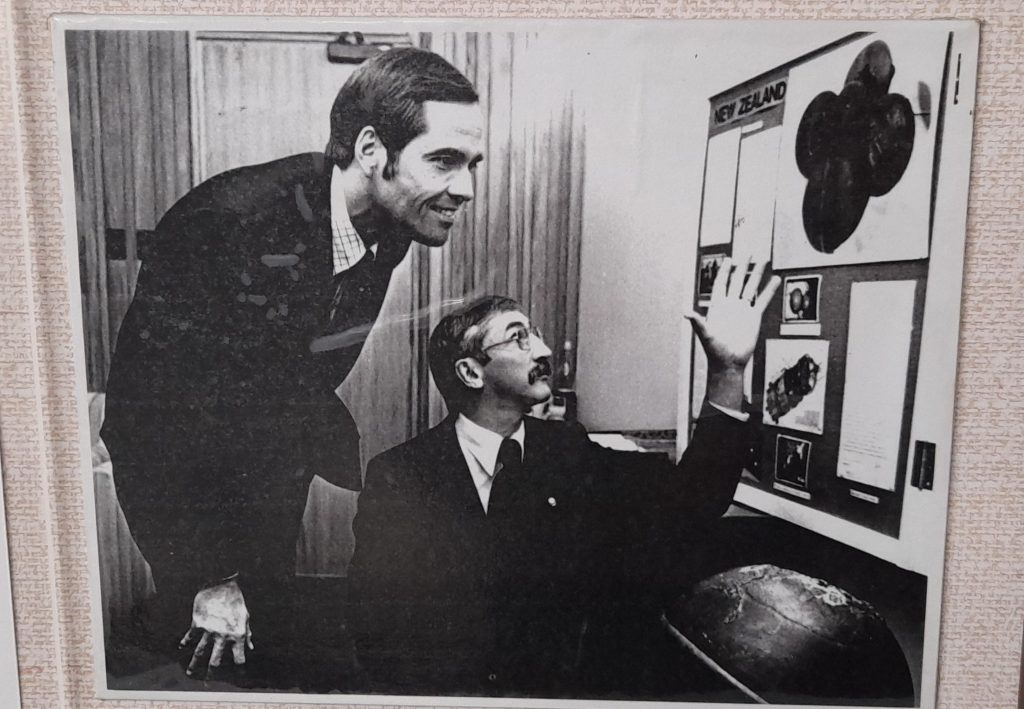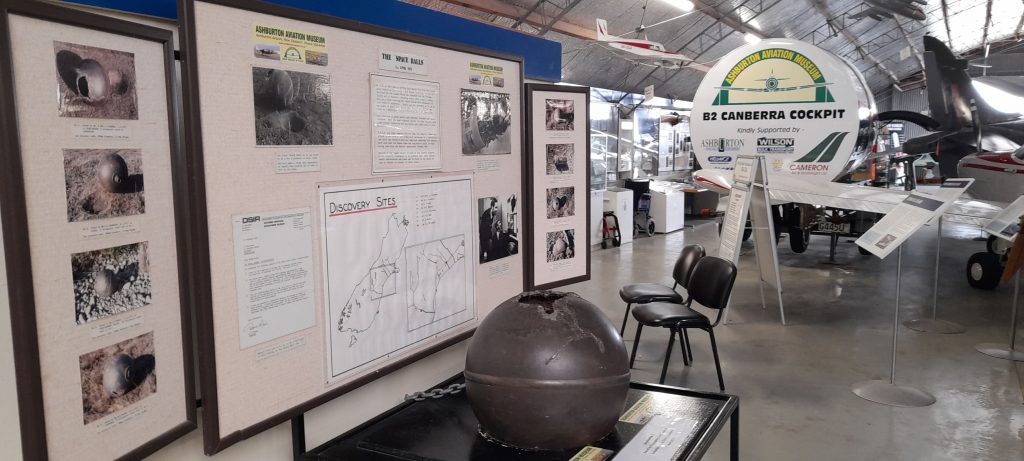
Today, back in 1972, a ball of fire with a long tail was seen falling from the sky and later a strange metal sphere was found lying in a field, near Ashburton.
The sphere weighed 13.6kg, had a diameter of 380mm, and left a hole in the ground 150mm deep.
In the months following five more spheres were found across Mid and South Canterbury, as well as a cylinder and metal fragments.
The sphere, on show at Ashburton Aviation Museum, has generated years of public interest.
Aviation museum president Stephen Johnston said the Lindores Spaceball, as it became known, was found on April 3, 1972, at Huntingdon, southeast of Ashburton.
‘‘It’s the only one on permanent display that we know of,’’ Johnston said.

The sphere was accessible for people to touch, and information panels showed where and when the other items were found.
Other spheres were found at Hinds, Hakataramea Valley, Lynnford and Ealing with a cylinder found at Lake Aviemore and metal fragment at Rangitata River, near Peel Forest.
About two years the Ashburton Museum ran an exhibition with about five of the spaceballs, he said.
‘‘We would like to have the others to put on display, but at this stage we only have this one.’’
June Lindores and her late husband John, found the sphere object on their Huntingdon farm on April 3, 1972.
The pair had returned after a night away. It was in a paddock 50 metres from the drive, and about 200m from their house.
The surface of the paddock was hard and dry and the sphere had left a 150mm depression.
June, speaking to The Ashburton Courier last week, said at the time it was ‘‘quite frightening’’.
“We didn’t know (what it was) until other spaceballs were found and then they were able to track the route of it,’’ she said.

Police Sergeant JR Wheeler visited the farm and took it back to the station.
Lack of footprints and the depth of the indentation indicated it had dropped from a considerable height.
There was a lot of publicity around the sphere, but nobody claimed it, June said.
‘‘Everybody was very tightlipped.’’
June said there had been a drought and the paddock on their Huntingdon farm was just bare soil.
‘‘And there was this object. We didn’t know what it was. We thought it was an April Fool’s joke,’’ she said.
‘‘We didn’t know where it had come from.’’
It weighed 13.6kg, had a diameter of 380mm and was 7mm thick.

The late Jim Chivers, a former aviation museum member, carried out research on the spaceballs collection in December 2009.
It detailed the investigations and sightings recorded at the time, as well as information about the spaceballs.
On one side of the Lindores Spaceball was a jagged irregular hole about 150mm x 75mm where metal had been flung back.
It had exposed bright gold, purple and other coloured metals.
At the opposite side was a small hole with a raised surface on the outside, indicating something may have been fitted to it.
Molten metal had hardened on the inside of the small hole.
The metal object’s two halves fitted together in what a spokesperson for a welding firm at the time called a really perfect welding job.
One of many newspaper reports at the time had an account from three Oamaru students camped at Lake Ohau over Easter.
Colin Norris, Geoffrey Omnet and Barry Stanger, all 16, had their own view at 1am on April 3, 1972.
They said they saw nine bright white objects trailing long white tails very similar to meteorites.
They appeared from the southwest over the Ben Ohau Range, descending low in the sky in a northeast direction.
The nine objects faded out one by one in the clear night sky and a few minutes later the boys heard a booming sound like thunder.
In Ashburton, Judy Skevington, 69, said at the time she was aged 16 and in a house on Harrison St near the shopping centre when she saw something falling from the sky.
“I knew it wasn’t a falling or shooting star. It was a ball of fire with a long tail,’’ Judy told The Courier.
‘‘I’m pretty sure it was the one that landed out this way (Huntingdon),’’ she said.
‘‘It was really bizarre to watch. As a teenager it was quite exciting as I hadn’t ever seen anything like it.’’
Jim reported that Sgt Wheeler, after taking the sphere away from the Lindores property, made inquiries with technical staff of the Royal New Zealand Air Force, and the US Navy Deep Freeze headquarters in an effort to clear up the mystery.
Two days later Captain DW Boucher of the USAF tracking station at Mt John, Lake Tekapo, examined the sphere.
He confirmed there was a strong possibility it could have belonged to a spacecraft which had disintegrated in space three days earlier.

Boucher said assuming it was from a spacecraft, it would have been travelling at 27,000kph when it hit the Earth’s atmosphere and about 320kmh when it landed on the Huntingdon farm.
It was tested for radioactivity but cleared.
It was found to be made of titanium-based ally used to make aircraft and spacecraft and was not magnetic.
The United States and the former Soviet Union denied ownership.
But most experts pointed to the debris being pressure gas tanks from the control system of a Soviet space craft launch vehicle.
June told The Courier that when the sphere was taken away the family did not know if it would be returned.
They kept a scrapbook of record over the years.
‘‘We were amazed when the next we heard about it, it was on TV and the DSIR were cutting a piece out of it.’’
The Lindores Spaceball is a permanent display at the Ashburton Aviation Museum.
‘‘I’m pleased it is out at the museum where other people can see it.’’
Over the years it had created quite a lot of interest and quite a lot of disbelief, she said.
‘‘And it just keeps surfacing.’’



